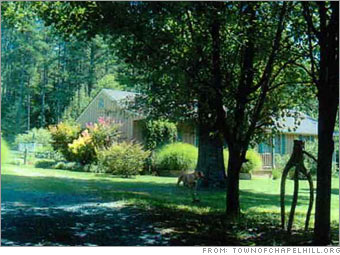Gardening for Everyone
A Lesson Learned from North Carolina
Donald McInnes, Ph.D.
Recently my family borrowed a house in Chapel Hill, NC, for several weeks while my wife was receiving medical treatment at Duke (one reason my contributions to this publication have been less than regular this year). We weren’t looking to borrow a house—we would have considered ourselves lucky to find a summer sublet in a convenient location. When a friend (and former Columbia resident) posted on her neighborhood association’s website that we were looking for a place to live, we received a few responses, one of which was an offer to stay for free while the home-owning family was away visiting family. We are truly grateful for the kindness of strangers.
 Chapel Hill has a different aesthetic than Columbia (and I don’t only mean the many young men always dressed as if they’re going to a polo match, in pastel linen or polo shirts and seersucker pants. Every day in Chapel Hill is like…, well, the only other place I’ve seen so much seersucker is at the steeplechase races in Camden). The landscape aesthetic in Chapel Hill, however, is one I can get behind. The house we borrowed has only, perhaps, 200 ft2 of lawn—a narrow patch along the road. The rest of the property was wooded. This seemed typical for the area.
Chapel Hill has a different aesthetic than Columbia (and I don’t only mean the many young men always dressed as if they’re going to a polo match, in pastel linen or polo shirts and seersucker pants. Every day in Chapel Hill is like…, well, the only other place I’ve seen so much seersucker is at the steeplechase races in Camden). The landscape aesthetic in Chapel Hill, however, is one I can get behind. The house we borrowed has only, perhaps, 200 ft2 of lawn—a narrow patch along the road. The rest of the property was wooded. This seemed typical for the area.
I spent about three hours this morning weeding, mowing, edging, and blowing my Columbia property. It makes me miss the Chapel Hill house. Having a lawn takes a lot of time. And that required time is not nearly as flexible as the landscape chores around a house in the woods. Your lawn will suffer if you put off mowing it for weeks at a time—but pruning trees and shrubs can be postponed until a more convenient time or more pleasant weather.
The house we borrowed was owned by a couple of UNC Political Science professors, and it was evident their landscape was a low priority in their busy lives. In the weeks we were there, I borrowed a chainsaw and took down a recently deceased winged elm tree (likely a victim of Dutch elm disease), pruned (not with the chainsaw) the azaleas and other shrubs blocking the front walkway, and did a bit of other cleaning up. The amount of time I spent was probably not a whole lot less than I’d have spent on my own property during those weeks, but the homeowners shouldn’t have much to do (other than mow their tiny bit of turf) until next summer, when some of the shrubs will need pruning again.
There’s no substitute for a good lawn if you want to play ball, but if your landscape is maturing—the trees growing to a size where their shade and root competition are detrimental to the lawn—consider giving up on the lawn in those areas. You may be able to switch your grass type to one more tolerant of shade, and you could prune the trees to allow more light, but these are expensive endeavors and not prudent investments–in a few years (or sooner) the trees will be casting even more shade, and the lawn will again be suffering.
In shady spots, weeds are much less likely to sprout, so wooded landscapes require less weed pulling (and less spraying of potentially dangerous herbicides (I read an article last night linking another weed killer to autism)). While pruning trees and shrubs requires more skill and understanding of plants than mowing turf, once you gain confidence with pruning shears (something I can help you with), you’ll have much less work to do caring for your patch of forest than you would caring for a lawn of the same size. Consider reducing the lawn to the sunniest spots, or even eliminating it entirely. Trust me; you won’t miss the mowing, weeding, edging, fertilizing, liming, etc.
Don has degrees in biology from Duke, Northwestern and Florida State. He has worked for Clemson Extension in Richland County since 2000, assisting thousands of consumers with landscape, garden, wildlife and pest control questions. He is also the owner of Southeastern Environmental Design, a landscape coaching, consulting and design service. He’d be happy to help you master your landscape, whether you need extensive help, or just an hour or two of instruction on how to do it yourself.





